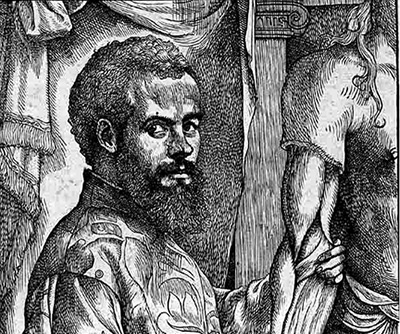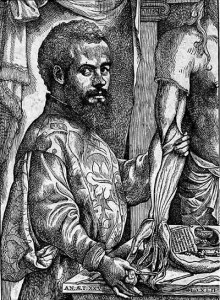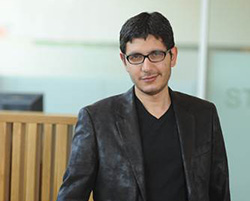
Accounting for an Historic Text

The life of a book can be as interesting and long lasting as the contents within. Such is the tale of the historic text The Fabric of the Human Body by anatomist Andreas Vesalius. Recently, Dr. Stephen N. Joffe, a retired UC professor of surgery and medicine, and Veronica Buchanan, archivist in the Henry R. Winkler Center for the History of Medicine, embarked on a project to account for the locations in the United States of both the first (1543) and second editions (1555) of this seminal work whose author was among the first to accurately depict the human body and to illustrate anatomy in a visual way.
Andreas Vesalius was born in Brussels in 1514 and was educated in France, Belgium and Italy. In 1543 he published a unique anatomical atlas. Called De Humani Corporis Fabrica [The Fabric of the Human Body], the book was an instant sell out and improvements and corrections were made for a second edition published in 1555. Vesalius died in 1564 at age 50 years while on a pilgrim ship to Israel and was buried in an unmarked grave on a remote Greek island. Though Vesalius’s life and career where cut short, his work revolutionized not only the science of anatomy but also the manner in which it was taught and standardized anatomical representation for the next 200 years.
Joffe and Buchanan set about their census of the first and second editions of the Fabrica by contacting institutions of higher learning, museum libraries and libraries of national collections, research institutions and antique book dealers. In addition, they did Internet searches, communicated through list serves, attended book auctions and contacted private collectors. In addition to counting the known copies, they also inquired how the institution came to have the book and requested a description of its condition and binding. If available, they asked for a photograph of the book.
Sixty-four copies of the 1543 Fabrica were recorded in 47 universities and institutional libraries in the U.S. Besides confirming their presence at the previously recorded sites, they also found 18 more copies in 12 additional facilities including copies with colored and tinted illustrations. A total of 58 copies of the 1555 Fabrica were found in 49 university and institutional libraries in the U.S. A previous census of the 1555 Fabrica done in 2009 found only 45 books in 34 locations.
“A collaboration with the Winkler Center offered access to a large network of national health science libraries providing a wealth of information rapidly. Ms. Buchanan was masterful at accessing, accumulating and collating the information,” said Dr. Joffe.
The Winkler Center is a medical archive, library and exhibit facility that encourages visitors and researchers to explore the Cincinnati area’s rich medical history and to discover the people who have contributed to important advances in medicine, nursing and pharmaceutical sciences. While the center does not own either the first or second edition of The Fabric of the Human Body, they do have a 1934 edition (the last one printed) in their collection as well as many other historical anatomy books.
A full report of Joffe’s and Buchanan’s census can be found in a recent article published in the International Archives of Medicine, available online at http://imed.pub/ojs/index.php/iam/article/view/1040/685 . For more on the Winkler Center, visit them on the web at http://www.libraries.uc.edu/winkler-center.html.




